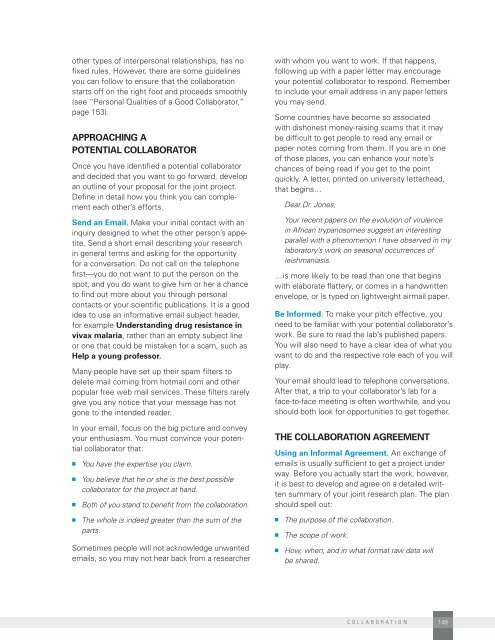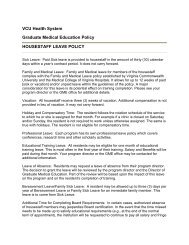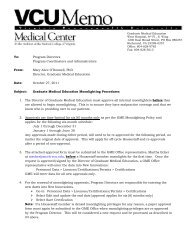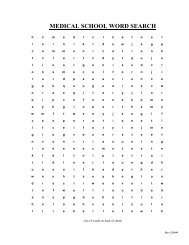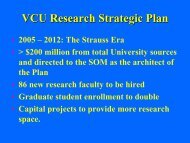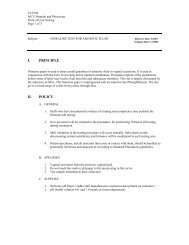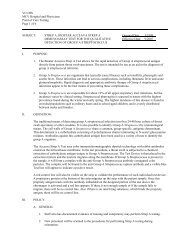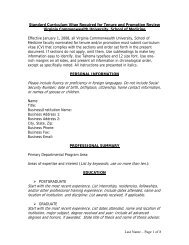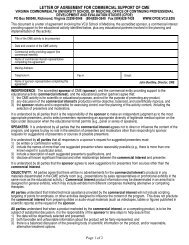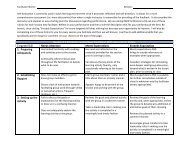n Is travel safe and convenient, or will each tripinvolve logistical headaches and considerableuncertainty?n How good are the channels <strong>of</strong> communication?Will you be able to talk by phone (or internet phone)easily? Is email between you quick and reliable?n Do I know the language <strong>of</strong> my potential collaborators?Do they know mine? Will we be able tocommunicate effectively both about science andabout the more subtle human factors that will beinvolved in a good collaboration—for example,knowing when to “push” and when to let theother person have some time to respond?n Will scientific papers be published in a languagein which I am not fluent? If so, how can I vouchfor the translation? How can I be sure my group isinvolved properly in the writing and in authorshipcredit? Do my collaborator and I start with thesame assumptions about credit, publishing, andauthorship?Although physical and technical factors areimportant, it is the human dimension that most<strong>of</strong>ten makes or breaks a collaboration. Beespecially sensitive to emotions that may be inplay under the surface, especially if there is animbalance <strong>of</strong> resources (e.g., money, reagents, oraccess to required sites or populations) broughtinto the collaboration by each partner. For example,if your collaborators depend on you for access toa population group, your partners may grow toresent you for how you control this “doorway,”and you may grow to resent them for regardingyou as a door! If you are in a large institute withgood access to reagents and equipment and yourcollaboration is with a very small, under-fundedfacility, you may grow to resent your partners fortaking liberties with your generosity and takingmore <strong>of</strong> your resources than they need. Beingaware <strong>of</strong> these imbalances and trying to maintainyour own sense <strong>of</strong> good will can be very useful inkeeping things running smoothly.Two key ingredients should be in place at theoutset <strong>of</strong> a long, stable collaboration: a sharedunderstanding <strong>of</strong> potential funding so that yourpartnership can survive the perhaps inevitable upsand downs in support, and at least one individualin the other lab who is as committed to theproject as you are and is willing to help push pastroadblocks that may arise.Before making a decision about a collaboration,consider all factors. A good collaboration cantake your research in a completely unexpecteddirection. A bad one can waste your energy anddemoralize you.SETTING UP ACOLLABORATIONSomeone may eventually ask you to collaborate,but if you are a beginning investigator, it is morelikely that you will need to approach a potentialcollaborator yourself. A collaboration, like manyQ u e s t i o nq&aIf a powerful person asks me to collaborate but the proposed partnership does not suit me,how do I politely decline?answerExplain that you do not have the resources at the moment to enter a collaborative project. Offer instead toprovide input and suggestions into the research and, if possible, suggest other people with similar expertisewho may be good collaborators.148 excellence everywhere
other types <strong>of</strong> interpersonal relationships, has n<strong>of</strong>ixed rules. However, there are some guidelinesyou can follow to ensure that the collaborationstarts <strong>of</strong>f on the right foot and proceeds smoothly(see “Personal Qualities <strong>of</strong> a Good Collaborator,”page 153).Approaching aPotential CollaboratorOnce you have identified a potential collaboratorand decided that you want to go forward, developan outline <strong>of</strong> your proposal for the joint project.Define in detail how you think you can complementeach other’s efforts.Send an Email. Make your initial contact with aninquiry designed to whet the other person’s appetite.Send a short email describing your researchin general terms and asking for the opportunityfor a conversation. Do not call on the telephonefirst—you do not want to put the person on thespot, and you do want to give him or her a chanceto find out more about you through personalcontacts or your scientific publications. It is a goodidea to use an informative email subject header,for example Understanding drug resistance invivax malaria, rather than an empty subject lineor one that could be mistaken for a scam, such asHelp a young pr<strong>of</strong>essor.Many people have set up their spam filters todelete mail coming from hotmail.com and otherpopular free web mail services. These filters rarelygive you any notice that your message has notgone to the intended reader.In your email, focus on the big picture and conveyyour enthusiasm. You must convince your potentialcollaborator that:n You have the expertise you claim.n You believe that he or she is the best possiblecollaborator for the project at hand.n Both <strong>of</strong> you stand to benefit from the collaboration.n The whole is indeed greater than the sum <strong>of</strong> theparts.Sometimes people will not acknowledge unwantedemails, so you may not hear back from a researcherwith whom you want to work. If that happens,following up with a paper letter may encourageyour potential collaborator to respond. Rememberto include your email address in any paper lettersyou may send.Some countries have become so associatedwith dishonest money-raising scams that it maybe difficult to get people to read any email orpaper notes coming from them. If you are in one<strong>of</strong> those places, you can enhance your note’schances <strong>of</strong> being read if you get to the pointquickly. A letter, printed on university letterhead,that begins…Dear Dr. Jones,Your recent papers on the evolution <strong>of</strong> virulencein African trypanosomes suggest an interestingparallel with a phenomenon I have observed in mylaboratory’s work on seasonal occurrences <strong>of</strong>leishmaniasis.…is more likely to be read than one that beginswith elaborate flattery, or comes in a handwrittenenvelope, or is typed on lightweight airmail paper.Be Informed. To make your pitch effective, youneed to be familiar with your potential collaborator’swork. Be sure to read the lab’s published papers.You will also need to have a clear idea <strong>of</strong> what youwant to do and the respective role each <strong>of</strong> you willplay.Your email should lead to telephone conversations.After that, a trip to your collaborator’s lab for aface-to-face meeting is <strong>of</strong>ten worthwhile, and youshould both look for opportunities to get together.The Collaboration AgreementUsing an Informal Agreement. An exchange <strong>of</strong>emails is usually sufficient to get a project underway. Before you actually start the work, however,it is best to develop and agree on a detailed writtensummary <strong>of</strong> your joint research plan. The planshould spell out:n The purpose <strong>of</strong> the collaboration.n The scope <strong>of</strong> work.n How, when, and in what format raw data willbe shared.collaboration149
- Page 3 and 4:
A R e s o u r c e f o r S c i e n t
- Page 5 and 6:
Table of ContentsVII119PrefaceChapt
- Page 7:
135 Chapter 10E x p a n d i n g Y o
- Page 15 and 16:
Q u e s t i o nq&aWhat Is a “Tenu
- Page 17:
preparing for immediate submission,
- Page 22 and 23:
Practicing the Talkn Practice your
- Page 24 and 25:
your one-on-one interviews you have
- Page 26 and 27:
If talking directly about money is
- Page 28 and 29:
When the institution responds and y
- Page 30 and 31:
equipment and supplies. Maintenance
- Page 32 and 33:
Q u e s t i o nq&aIs your instituti
- Page 34 and 35:
Working With Human SubjectsWhether
- Page 36 and 37:
RESPONSIBILITIES BEYONDTHE LABORATO
- Page 38 and 39:
UNDERSTANDING YOURINSTITUTION AND H
- Page 40:
Criteria for PromotionStructure of
- Page 45 and 46:
Q u e s t i o nWhat’s in a Name?q
- Page 47 and 48:
Screening ApplicantsWhen you review
- Page 50 and 51:
Interpersonal Skillsn How important
- Page 52 and 53:
Multinational Organizations are hir
- Page 54 and 55:
n If there is an office that handle
- Page 57 and 58:
n Seek funding and publish papers (
- Page 59 and 60:
In fact, even though you yourself h
- Page 61 and 62:
n Craft a statement that you feel c
- Page 63 and 64:
n When you delegate authority to so
- Page 65 and 66:
n Use only pens, preferably with wa
- Page 67 and 68:
Strategy sessionsShould you decide
- Page 69 and 70:
Finding Good Papers for Journal Clu
- Page 71 and 72:
If possible, invite people in your
- Page 73 and 74:
Q u e s t i o nq&aHow do I avoid po
- Page 75 and 76:
The International Committee of Medi
- Page 77 and 78:
Managing Conflictin the LabConflict
- Page 79 and 80:
steps for dealing with conflictWhen
- Page 81 and 82:
chapter 5managing your time“ Succ
- Page 83 and 84:
Check your work: the 90-year though
- Page 85 and 86:
n Make and keep appointments with y
- Page 87 and 88:
n Help them seek advice without tak
- Page 89 and 90:
FAMILY MATTERSMany scientists face
- Page 91 and 92:
chapter 6project management“ We m
- Page 93 and 94:
My project is to get a grant funded
- Page 95:
ObjectivesObjectives are the end re
- Page 98 and 99:
The key events schedule and the act
- Page 100 and 101:
Microsoft Project, a program that s
- Page 102 and 103:
Martin, Vivien. Managing Projects i
- Page 104 and 105:
appendix II: Example of a Work Brea
- Page 106 and 107:
appendix iv: Example of a Gantt Cha
- Page 108 and 109: e h i n d c l o s e d d o o r s :w
- Page 110 and 111: Who might be interested in supporti
- Page 112 and 113: Call your program officerProgram of
- Page 114 and 115: direct costs vs. indirect costsDire
- Page 116 and 117: RESOURCESAllen, Ernest M. “Why ar
- Page 118 and 119: the next generation of students (th
- Page 120 and 121: Seek Feedback through a Formal Peer
- Page 122 and 123: Encouraging Student Questionsn Do n
- Page 124 and 125: Here are some ways you can help the
- Page 126 and 127: n Are there curriculum changes unde
- Page 128 and 129: a relaxed format for talking about
- Page 130 and 131: spend in preparing an effective cou
- Page 132 and 133: The Publishing ProcessTypes of Jour
- Page 134 and 135: A word about impact factorsThe impa
- Page 136 and 137: C r e a t i n g a n i n t e g r a t
- Page 138 and 139: may need to take the first author p
- Page 140 and 141: submitting image filesToday, most i
- Page 142 and 143: Submitting your Paper to Another Jo
- Page 144 and 145: RESOURCESDavis, Martha. Scientific
- Page 146 and 147: increase your impact as a scientist
- Page 148 and 149: Q u e s t i o nq&aHow do I communic
- Page 150 and 151: n Offer criticism and correction in
- Page 152 and 153: It is important to discuss career g
- Page 154 and 155: When Mentoring,Advisory, or Supervi
- Page 156 and 157: For researchers in developing count
- Page 160 and 161: n The expected contribution of each
- Page 162 and 163: Meetings. Set up systems to ensure
- Page 164 and 165: SPECIAL CHALLENGESFOR THE BEGINNING
- Page 166 and 167: e an important connection to future
- Page 168 and 169: The invention of a new method or pr
- Page 170 and 171: licensee, who can charge others for
- Page 172 and 173: Most profound for developing countr
- Page 174 and 175: Finally, the patents have been chal
- Page 176 and 177: And, India benefited as a supplier
- Page 178 and 179: paperwork involved in purchasing1.
- Page 180 and 181: labeling mattersA case in point: In
- Page 182 and 183: equipment, freeze-drying equipment,
- Page 184 and 185: Responsibilityfor materialsIf an or
- Page 186 and 187: Recent Improvementsin Materials Tra
- Page 188 and 189: “Knowledge is power.” —Sir Fr
- Page 190 and 191: MOUMemorandum of UnderstandingRFPRe
- Page 192 and 193: notes continued182 excellence every
- Page 194: notes continued184 excellence every


